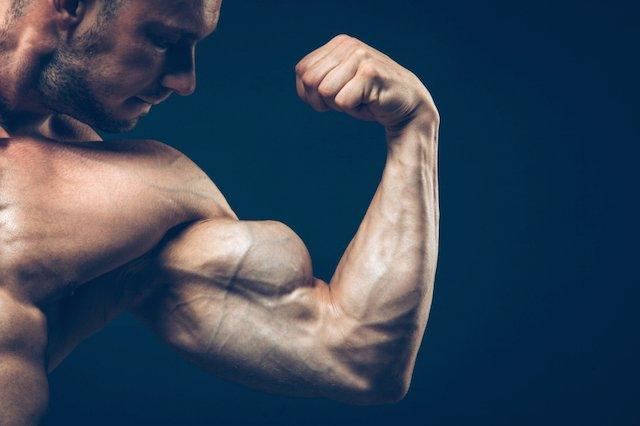

Post-Exercise "T-Levels" Predict Future Muscle Growth
Table of Contents
Post-Exercise “T-Levels” Predict Future Muscle Growth
by: Robbie Durand
For years, bodybuilders have been advocated to use short rest periods between sets to elicit metabolic stress and increase anabolic hormone responses. Various hormones have been shown to alter the dynamic balance between anabolic (i.e. testosterone, GH, IGF-1) and catabolic (i.e. cortisol) stimuli in muscle, helping to mediate an increase or decrease in muscle protein synthesis. Testosterone is not readily available to the androgen receptor. The vast majority of circulating testosterone is bound to either albumin (38%) or steroid hormone binding globulin (60%), with the remaining 2% flowing in a free, unbound state that is available to bind to the receptor. This means only a subtle portion of free testosterone is readily available to bind to the receptor in muscle.
Metabolic Stress Increases Anabolic Hormones
It is believed that high metabolic stress associated with such routines potentiates post-exercise hormonal release. Resistance exercise that involves high volume training with short rest periods can stimulate anabolic hormones. For example, numerous studies using resistance exercise training combined with blood flow restriction have shown to increase muscle hypertrophy with a training intensity as low as 20% 1RM. For instance, a low-intensity (~50% 1RM) resistance training performed with leg extensions caused a marked increase in muscular size ~12% gain in muscle size and strength (~20% gain) when combined with moderate vascular occlusion. These studies suggest that the muscle mass building effects of resistance exercise involve not only muscle tension (weight) but also metabolic factors such as GH and testosterone.
 Hormones such as human growth hormone (GH), testosterone, and IGF-1 have been shown to play a role in muscle hypertrophy and strength gains. The prevailing dogma for the past 50 years has been that testosterone increases muscle mass by stimulating fractional muscle protein synthesis. Testosterone administration also results in increases in GH secretion, androgen receptor number, satellite cell activity, and increased IGF-I expression in skeletal muscle. It’s also been demonstrated that the increase in muscle anabolism is associated with an increase in the expression of intramuscular mRNA IGF-I. GH is also highly recognized for its role in muscle growth. Resistance exercise stimulates the release of GH from the anterior pituitary gland, with released levels being very dependent on exercise intensity. GH helps to trigger fat metabolism for energy use in the muscle growth process. As well, GH stimulates the uptake and incorporation of amino acids into protein in skeletal muscle. In humans, GH administration is known to increase both whole-body and muscle protein synthesis and almost unequivocally to increase lean body mass and decreased fat mass. Human growth hormone also stimulates liver production of circulating IGF-1 concentrations and may also stimulate IGF-1 production in other tissue such as skeletal muscle.
Hormones such as human growth hormone (GH), testosterone, and IGF-1 have been shown to play a role in muscle hypertrophy and strength gains. The prevailing dogma for the past 50 years has been that testosterone increases muscle mass by stimulating fractional muscle protein synthesis. Testosterone administration also results in increases in GH secretion, androgen receptor number, satellite cell activity, and increased IGF-I expression in skeletal muscle. It’s also been demonstrated that the increase in muscle anabolism is associated with an increase in the expression of intramuscular mRNA IGF-I. GH is also highly recognized for its role in muscle growth. Resistance exercise stimulates the release of GH from the anterior pituitary gland, with released levels being very dependent on exercise intensity. GH helps to trigger fat metabolism for energy use in the muscle growth process. As well, GH stimulates the uptake and incorporation of amino acids into protein in skeletal muscle. In humans, GH administration is known to increase both whole-body and muscle protein synthesis and almost unequivocally to increase lean body mass and decreased fat mass. Human growth hormone also stimulates liver production of circulating IGF-1 concentrations and may also stimulate IGF-1 production in other tissue such as skeletal muscle.
There has been much debate as to the impact of acute anabolic hormones on muscle growth. Some studies have shown a positive effect on muscle growth, whereas other have found no impact on muscle growth. The proponents of acute exercise anabolic hormones have hypothesized that elevations in acute anabolic hormones increase the likelihood of androgen receptor binding and initiating a cascade of intracellular reactions that affects muscle growth.
Post-Exercise Testosterone Levels Stimulate Muscle Gains
 Researchers examined in the Journal of Strength and Conditioning Research the impact of post-exercise hormones on Muscle growth. Pre-testing measures of muscle size (thickness and cross-sectional area) of the legs were collected in 26 resistance-trained men. Participants were randomly selected to complete a high-volume exercise program consisting of 10–12 repetitions, 1-min rest periods) or high-intensity (3–5RM, 3-min rest periods) resistance training program. During training, participants were required to complete at least 28 resistance training sessions (~90%) of an 8-wk resistance-training program (4 sessions · week) that included six upper- and lower-body exercises during each session. Blood samples were collected at baseline, immediately post-exercise, 30-min, and 60-min post-exercise during weeks 1 (WK1) and 8 (WK8) of training.
Researchers examined in the Journal of Strength and Conditioning Research the impact of post-exercise hormones on Muscle growth. Pre-testing measures of muscle size (thickness and cross-sectional area) of the legs were collected in 26 resistance-trained men. Participants were randomly selected to complete a high-volume exercise program consisting of 10–12 repetitions, 1-min rest periods) or high-intensity (3–5RM, 3-min rest periods) resistance training program. During training, participants were required to complete at least 28 resistance training sessions (~90%) of an 8-wk resistance-training program (4 sessions · week) that included six upper- and lower-body exercises during each session. Blood samples were collected at baseline, immediately post-exercise, 30-min, and 60-min post-exercise during weeks 1 (WK1) and 8 (WK8) of training.
At the end, if the study, of all the hormones, measured, only testosterone is related to muscle hypertrophy across eight weeks of training. There were no significant pathways observed in the other hormones studies such as cortisol, GH, IGF-1, or insulin. The findings indicate that baseline muscle size and the hormonal response to resistance exercise are related to muscle hypertrophy following eight weeks of training. Further, the observed relationships appear to remain consistent regardless of whether resistance training emphasizes training volume or intensity.
Key Points: Only Post-Exercise Testosterone after exercise was found to be indicative of muscle growth
Mangine, Gerald T., et al. “Exercise-Induced Hormone Elevations Are Related To Muscle Growth.” The Journal of Strength & Conditioning Research (2016).
MUSCLE MEDIA MAGAZINE FOR MEN
The premier source of training, nutrition, supplements, fat loss and health for men.

















